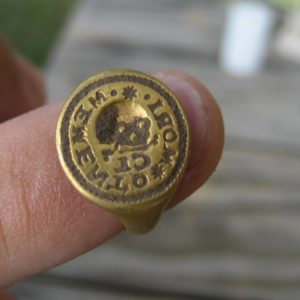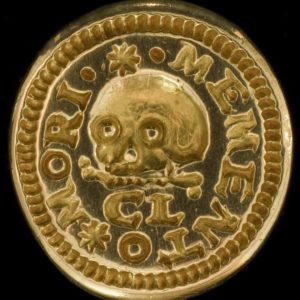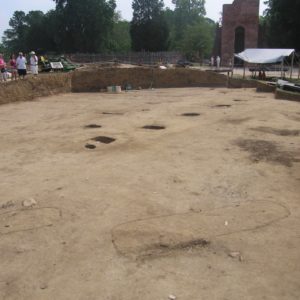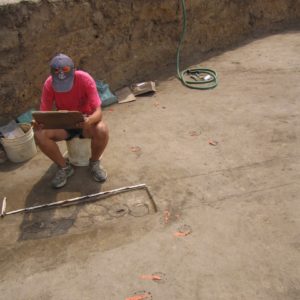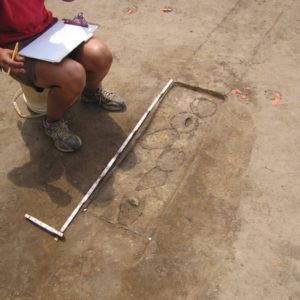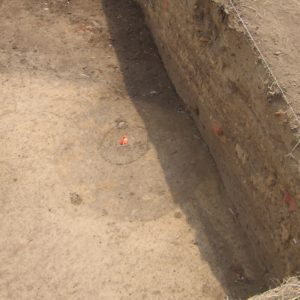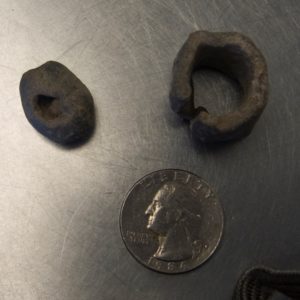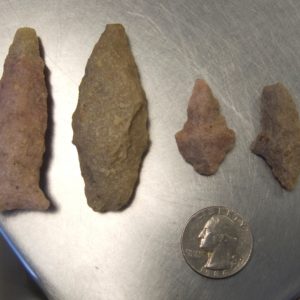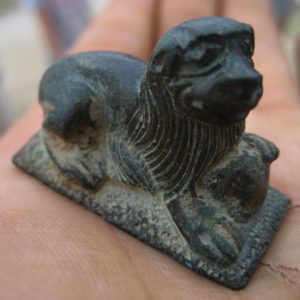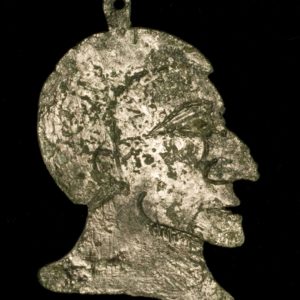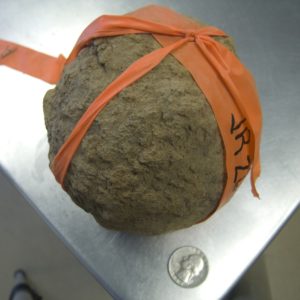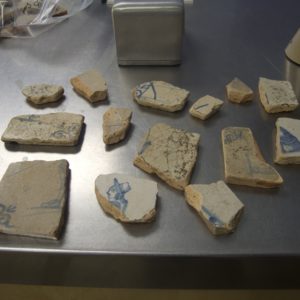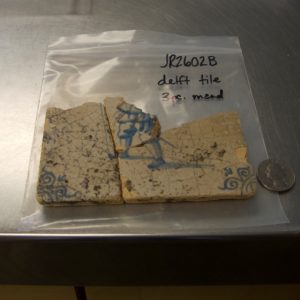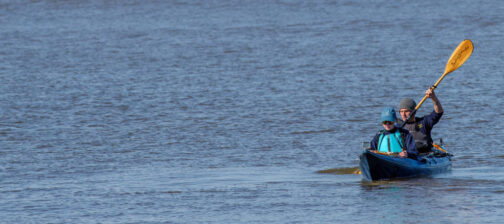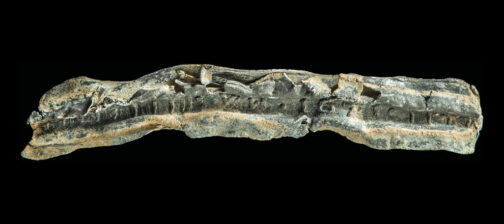Despite the intense Virginia heat, the Jamestown Rediscovery archaeological team and the students from the 2008 Field School have made steady progress excavating 10′ x 10′ squares inside James Fort. Archaeologists believe they may have found the fort’s original storehouse, described by the colonists as being 120 feet long and 40 feet wide. A line of regularly spaced, deep, and abnormally large postholes running near the center of the fort could be evidence of the structure. Nearby, a series of smaller postholes appears to the be the remnants of a garden fence dating to the 1680s or 1690s, near the end of Jamestown’s reign as capital of Virginia. The footprint of a Virginia Indian structure was discovered only feet away from the fence but it had ceased to exist years before the arrival of the colonists. Artifacts have been turning up in droves.
The footprint of a very large building near the center of James Fort is slowly being uncovered. Archaeologists are speculating that they’re uncovering the fort’s storehouse, described by the colonists as being 120 feet long and 40 feet wide. The evidence comes in the form of large postholes spaced an even 10 feet apart. These postholes once held the logs that served as the main support posts for the structure above. Being around 10″ in diameter, the postmolds themselves (the soil stains left by the decayed log) are unusually large, suggesting the building it supported was quite substantial. The posts’ stains reach deep into the ground, another indication that the building was a large one. These new postholes form a straight line with others found in 2005, all of which were of similar depth and diameter to the new finds. Only prehistoric artifacts are being found in the postholes; this suggests that the structure is indeed very early. Later construction usually contains colonial artifacts from earlier habitation of the same land since the fort area was used and reused so often during the 17th century. One of the newly discovered posts was found under the moat for the Confederate gun platform built in 1861. Using the established line and spacing of the other posts, archaeologists are now searching for more of the structure’s postholes by digging test trenches where the other postholes should be.
A bit to the west of this line of postholes the remnants of what was probably a garden fence is being uncovered. A series of postmolds has been found in a slot trench that appears to line up with the wine cellar discovered in 2004. The wine cellar dates to the 1680s or 1690s, which suggests that the garden fence is late 17th century. A number of trenches discovered in 2007 further to the south near the riverbank also appear to line up with this fence, and the artifacts discovered there also point to the later years of Jamestown’s existence as Virginia’s capital. Very close to the garden fence are a series of postholes that were part of a Native American structure built years before the colonists’ arrival. The posts are much smaller than those used by the colonists for their buildings. A wealth of Native pottery sherds and projectile points has been found in this area.
Another grouping of postholes has also been found nearby, but the inconsistent depth of the postmolds suggests that they are not all from the same building. Further excavation in the area may turn up more clues regarding these posts. A nearby hole revealed a cannonball for a piece of artillery known as a saker. The purpose of the hole itself is unknown and its excavation gave few clues regarding its function.
Farther to the north and east excavations continue in the area of a cellar of a mid-17th-century building that had been severely damaged by fire. There was thought that this might have been the cellar of a house owned by colonist Sara Drummond, whose house was burned during Bacon’s Rebellion in 1676. Artifacts and soil stains, however, point to an earlier date, probably in the 1630s or 1640s. Just feet from the cellar are several deep plow scars, probably dating to the late 18th century. These scars are a reminder of the centuries of use and reuse of the island even after the capital’s move to Williamsburg in 1699. Human bones, including several teeth, are being found in the Confederate fort fill above. These are probably the remains of colonists that were disturbed when the Confederate fort was built in 1861.
The past couple of months have been busy for the curatorial and conservation staff as the Field School and archaeological staff have excavated square upon square of earth inside James Fort. Artifacts have been pouring out of the site, including some rather unique and exciting examples such as a gold Memento Mori ring, a Nuremberg lion counterweight, a brass medallion commemorating the induction of Maurice of Nassau into the English order of Knights of the Garter, and a copper pendant which may be the profile of a Virginia Indian.
An early-17th-century gold ring was discovered by one of the Field School students sifting through plowzone fill from near James Fort’s center. Finding gold artifacts at Historic Jamestowne is a very rare occurrence, but even more interesting than the ring’s chemical composition is its design. The likeness of a skull has been engraved into the center of the ring’s face. Just below it are the letters “CL.” Surrounding the face is the Latin phrase “Memento Mori” which translates to “remember thy death.” There is speculation that perhaps the ring belonged to Captain Christopher Lawne who arrived at Jamestown from England in April 1619. He was a member of the first Virginia General Assembly and established one of the first settlements in present day Isle of Wight County. Only a man of some wealth and stature would have worn such an expensive piece of jewelry, and its message was appropriate given Lawne’s death in November 1619, only seven months after he arrived in Virginia.
Another artifact found by the 2008 Field School is a coin scale counterweight in the form of a lion. Made in Nuremberg, Germany, the lion served to keep the scales suspended while they were in use. Coins in this period were often made of precious metals and were thus literally worth their weight in their metal of origin. Coin weights were used to verify that gold coins contained the standard amount of gold. Jamestown Rediscovery archaeologists have found many coin weights over the years, but no gold coins.
Another notable artifact found this summer is a brass medallion bearing the likeness of Maurice of Nassau, Prince of Orange. The medallion was made to commemorate his induction into the English order of Knights of the Garter in 1612. George Yeardley, three-time governor of Virginia, may have owned the object, as he served under Prince Maurice while fighting against the Spanish in the Netherlands. A similar medallion was found by archaeologists several miles upriver from Jamestown at Flowerdew Hundred, Yeardley’s plantation.
A copper pendant found buried in the early fort-period cellar excavated earlier this year could be the profile of a Powhatan Indian. Bly Straube, Senior Curator at Historic Jamestowne, notes that the pendant may have been a type of identification badge for an Indian entering the fort. If it is indeed the likeness of a Powhatan Indian, it is one of only four known to exist outside of the 1580s drawings made by John White of the Roanoke, North Carolina colony.
related images
- Memento mori ring
- Memento Mori ring. The ring was created with a reverse facing so it would create a correctly-oriented imprint when sealing documents with hot wax.
- A view of the dig. Human burials in foreground.
- Orange tags mark the locations of postholes for a Native American structure built years before the colonists’ arrival.
- Postmolds from the logs used for the garden fence. The remnants of the decayed logs give the soil a different color than the surrounding area
- Another possible storehouse posthole found near the cellar excavations
- One of the possible storehouse postholes and a slot trench where a garden fence once stood
- Lead fishing weights
- Quartzite stone tools made by Native Americans
- Nuremberg lion counterweight
- Profile pendant
- A cannonball for a saker
- Delftware tile fragments. These tiles were used to surround fireplaces and decorate walls in the same manner as molding along floorboards.
- Three pieces of a delftware tile that have been mended together by the curatorial staff
- A seal bearing the likeness of a bird. Seals such as these were used to press designs into hot wax on documents.



